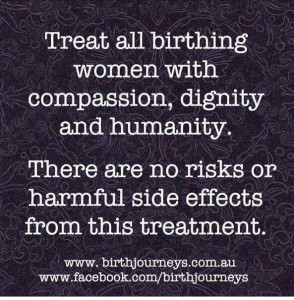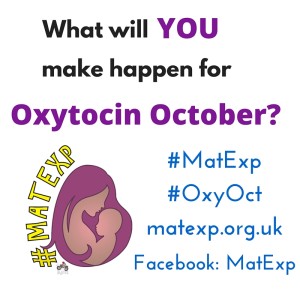A blog post from #MatExp co-founder Florence Wilcock.
There has been much discussion recently about safety within maternity services including a discussion on #MatExp Facebook group. A particular issue that bothers me is the idea that safety and experience might be two separate and mutually exclusive issues and it is this thought that drives me to write today.
Safety is paramount. The purpose of maternity services is to provide safe care through the journey of pregnancy and early newborn life. Every appointment in the NICE pathway is designed to screen for potential problems and ensure they are managed effectively. Every healthcare worker know this is the aim. The 20 week ‘anomaly’ scan might be considered the time to discover the sex of your baby if you wish and to get some photos but the medical purpose is to ensure the baby is growing well, with no abnormalities and to check where the placenta is localised to exclude placenta praevia (low lying placenta) which can cause life threatening bleeding.
But there is more to pregnancy and becoming a parent than safety isn’t there? I am currently reading Atul Gawande ‘Being Mortal’ where he eloquently demonstrates that keeping elderly people ‘safe’ is not enough, there is more to life and living than safety alone. He describes a number of times when giving elderly people purpose such as a plant or animal to look after or more freedom to live the way they wish despite disability it makes a significant difference to their wellbeing. Sometimes this path may deemed ‘less safe’ but for that individual may make all the difference. This comes back to choice. Safety & choice can be tricky ones to combine successfully.
This does not mean I am belittling safety. As a consultant obstetrician it falls to me to talk to couples when the worst has happened and their baby has died. I also care for women who have had unexpectedly life threatening complications. I know I am with them during probably some of the darkest hours they will ever experience. I cannot pretend to understand how they feel but I do know I have been part of those intimate moments of grief and with some families that has followed through into supporting them sometimes for years. As a hospital we have a robust process of incident reporting and the feedback from a Serious Incident investigation (SI) again will sometimes fall to me. In some cases there is nothing that we think could have been done differently in some cases I have to sit and tell an anguished couple that we have failed them and that maybe things could have been different. It is a devastating thing to do, there is absolutely nothing that can be said that will make the situation better. It feels as if you have personally taken their existing despair and dragged them into an even more unthinkable place and the only thing you can say is ‘sorry’ which feel hopelessly inadequate and trite for such a situation.
So if I could guarantee safety I would in a flash but it is not that simple. Maternity care is delivered by people and unfortunately to err is human. We cannot design a system free of risk because however hard we try the variable of human error gets in the way. We can introduce systems that help minimise the impact of these errors but we can’t eliminate them. My favourite analogy for risk management is James Reason’s model of Swiss cheese. The event only happens when the holes in the ‘cheese’ line up the rest of the time the barriers put in place prevent the error. An example in maternity care might be the introduction of what we call ‘fresh eyes’. A midwife looking after a woman on electronic fetal heart monitoring might misinterpret this or not see the subtle changes over time if she has it in front of her constantly. ‘Fresh eyes’ means another midwife or obstetrician comes and looks at the trace on an hourly basis. This means if unusually the first midwife has made an error there is a system that means it is more likely to be corrected.
The concept of a ‘No Blame’ culture is another example designed to minimise human error. The idea that if one sees or makes an error one should report it without fear so that learning can be gained from it. It may be the learning will be the need for some individual training but equally it might be something totally different. If staff are fearful of consequences then under reporting might be the result and safety gaps may not be identified. Encouraging openness about mistakes and errors is vital but difficult. In maternity it isn’t as if we can just operate our way out of this problem .We know the huge rise in Caesareans sections in the last 30 years has not improved the outcomes for babies but has instead cause maternal health problems. So in maternity as other medical specialties we have to constantly refresh and re-invent what we are doing to try and improve safety. As obstetricians we tread a difficult path trying constantly to call correctly just the right amount of intervention at just the right time.
So where does experience fit in I hear you ask? There is abundant published evidence of positive association of patient experience with clinical safety and effectiveness, in other words if your patients (or I prefer users) are having positive experiences then you are running a safer service. It’s hardly surprising if we communicate and explain things to women and their families that we will be more likely to communicate effectively to other members of the multidisciplinary team. If we are open and honest then woman can challenge assumptions and make sure we haven’t missed something critical, a woman knows her own history inside out whereas we might omit a key point. To me one of the most shocking things that was said at our ‘Whose shoes’ #MatExp workshop last year was that women can feel intimidated and unable to ask questions. Trust and understanding between health professionals and those we care for are vital. We cannot possibly hope to improve safety in isolation, experience has to improve too.
There are two specific elements of #MatExp of which I think epitomise the safety -experience overlap. The first is an on-going ever growing constructive conversation between women, families, obstetricians, midwives, health visitors, paediatricians, families and anyone involved in maternity services. Only by tackling the difficult conversations without hierarchy in an equal and respectful way can we improve maternity care. Listening and talking to one another is critical not only as we work with women but in dissolving those barriers and difficulties that sometime exist between different professionals. Flattening of hierarchy, team work and the ability of anyone to challenge is a well-recognised component of a safety culture. We are doing this both locally using the workshops and board game and more broadly via social media and the website.
The second element of #MatExp is that personal sense of responsibility to take action. Own what you are doing and why you are doing it. ‘Wrong is wrong even if everyone is doing it’ that doesn’t mean leave it to someone else. It means that health professionals and women can take action and influence maternity experience up and down the country and through that impact on and improve the safety of maternity care. So in final answer to my question I do not think it is a choice safety or experience I believe the two are fundamentally intertwined. So what will you do to improve #MatExp?
Florence Wilcock, 2015



